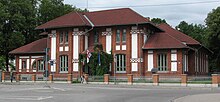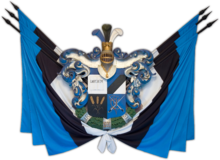Association of Estonian Students
The Estonian Student Association ( Estonian Eesti Üliõpilaste Selts - EÜS , Latin Societas Studiosorum Estonorum ) is the oldest, most important and largest Estonian student association. Until 1936 it was only open to students at the University of Tartu . Today all Estonian students can become members. Membership is granted for life.
history

Until the middle of the 19th century, studying at universities in Estonia and Livonia remained largely a privilege of the Baltic Germans . The German-Baltic student associations played an important role in the academic life of the Baltic region , especially at the German-speaking University of Dorpat, which has been German-speaking since 1802. Only with the emergence of national awareness among Estonians in the 19th century and the rise in the level of education of the native Estonian population did Estonians study in Tartu. They sought their own student organizations on an ethnic basis.
The forerunner of the Student Estonian Association was born on March 26th . / April 7, 1870 greg. founded in Tartu as a loose circle of friends. The founding members were eight Estonian students and Tartu intellectuals, including Andreas Kurrikoff , Heinrich Rosenthal, Hugo Treffner and Johann Voldemar Jannsen . Under the title “Kalevipoeg Evening”, the group decided to meet once a week to read the Estonian national epic Kalevipoeg and to deal with Estonian history , culture and language .
In 1873 the members gave themselves a fixed association statute under the name Vironia . The first chairman of the association was Andreas Kurrikoff. On May 23 jul. / June 4, 1881 greg. the foundation of the Estonian corporation Vironia was decided on the basis of the association . The Estonians sought recognition by the German umbrella organization Chargiertenconvent (Ch! C!), Which, however, met with resistance from the Baltic German corporations . A year later, Vironia withdrew from official recognition as a corporation.
In 1883, the then rector of the University of Tartu , Eduard Georg von Wahl (1833–1890), officially registered the Estonian Students' Association under its current name as a scientific and cultural society. The association became more and more the focal point of Estonian students in the Baltic States. However, the club's colors were not allowed to be worn in public.
On June 4, 1884, the association's official blue, black and white flag (later the flag of Estonia ) was solemnly consecrated in the pastoral hall of the Evangelical Lutheran Church of Otepää . The Philistine Association of the Student Estonian Association has also existed since 1884 .
Even after the founding of other Estonian student organizations ( Põhjala in Saint Petersburg in 1884 , Vironia Corporation in 1900 in Riga , Fraternitas Estica in Tartu in 1907), the EÜS remained the most important student organization in Estonia and Northern Livonia. In 1902 the club house in Tartu was completed.
Estonian independence
With the proclamation of Estonian independence in February 1918, the association remained a gathering point for patriotically-minded Estonian students and Philistines. The colors of the Student Estonian Association have been declared the Estonian national flag. On November 24, 1918, the members decided to take part "in corpore" in the Estonian war of freedom against Soviet Russia .
From 1921 the activities of the association went beyond Tartu. He was active all over Estonia and also represented in the capital Tallinn . At no time did the association strive to unite all Estonian students in the EÜS. The pluralism of student organizations in Estonia was preserved. The EÜS nonetheless played the most important role in interlinking the young academics with the young Republic of Estonia. The members of the association held important positions in the state, administration and business life.
Prohibition
With the Soviet occupation of Estonia, the Student Estonian Association - like the activities of all student organizations in Estonia - was banned on July 29, 1940. Some of its members were persecuted by the Soviet authorities and continued to operate underground and in Western European or American exile.
Re-establishment
On December 1, 1988, a meeting in Tartu decided to officially resume the association's activities in Estonia. In 1991 the University of Tartu de jure returned the club house that had been expropriated by the Soviets to the EÜS. On February 24, 1992, the original flag from 1884 was returned to the EÜS. In July 2009 a global meeting of the members was held in Tallinn, Tartu and Otepää.
Appreciation
The Student Estonian Association played an important role in the development of an Estonian national consciousness in the 19th century and anchoring it among the few Estonian academics of the time. It is not without reason that the blue, black and white tricolor of the EÜS has been the national flag of the Republic of Estonia since 1918. With Estonia's national independence in 1918, the Student Estonian Association became an influential network of nationally minded and state-sponsored students, professors and intellectuals. The association has retained this position to this day.
Color
Boys and old men wear a Baltic cover with the colors blue-black-white, which is embroidered with a Baltic star. Young members (i.e. foxes ) wear a blue lid with a Baltic star. Boys and old men wear blue-black-white ribbons without percussion. Heraldic rings are also worn.
Members
- Jakob Hurt (1839–1907), theologian, folklorist and linguist
- Gustav Ränk (1902–1998), ethnologist
- Toomas Hendrik Ilves (* 1953), 2006–2016 President of Estonia
- Indrek Tarand (* 1964), politician and journalist
- Mart Laar (* 1960), historian and politician; Prime Minister and Minister of Defense of Estonia
literature
- Kõpp, Johan: Eesti Üliõpilaste Seltsi Ajalugu 1870–1905. Tartu 1925.
- Heinrich Kolussi: From a Soviet star to a band of boys. Student corporations in the east before and after the "turning point" . Einst und Jetzt , Vol. 46 (2001), pp. 329-342.
- Vivat Academia. Üliõpilasseltsid ja -korporatsioonid Eestis. Tallinn 2007, ISBN 978-9985-9022-5-7 .
Web links
- Association of Estonian Students (Estonian, German, English)
- Ex est! Schmollis! Fiducite! ( Frankfurter Allgemeine Zeitung , June 16, 2008, accessed August 26, 2012)
Notes and individual references
- ^ Ernst Hans Eberhard : Handbook of the student liaison system. Leipzig, 1924/25, p. 200.
- ↑ Vironia is the Latin name of the North Estonian Wierland
- ↑ see charge (student union)



